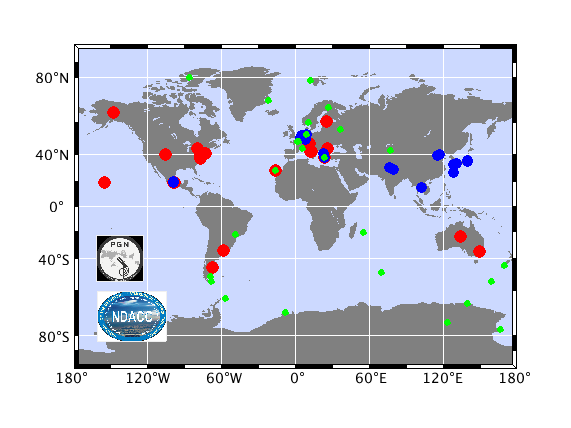Page 6 of 8
Correlative measurements used as reference for satellite validation are collected from several ground-based monitoring networks contributing to WMO's Global Atmosphere Watch:
- Zenith-Scattered-Light Differential Optical Absorption Spectroscopy UV-Visible spectrometers (ZSL-DOAS): About 30 ZSL-DOAS instruments perform network operation from the Arctic to the Antarctic, in the framework of the Network for the Detection of Atmospheric COmposition Change (NDACC).
- Multi-Axis Differential Optical Absorption Spectroscopy UV-Visible spectrometers (MAX-DOAS): Several of those instruments perform network operation in the framework of the Network for the Detection of Atmospheric COmpoisition Change (NDACC).
- Direct-sun Pandora spectrometers, also based on Differential Optical Absorption Spectroscopy (DOAS), perform network operation in the framework of the Pandonia Global Network (PGN).

Geographical distribution of the UV-visible DOAS spectrometers contributing NO2 correlative measurements to the validation of Sentinel-5p: 26 NDACC ZSL-DOAS (in green), 19 MAX-DOAS (in blue), and 25 PGN instruments (in red). (© Update of Verhoelst et al., 2021.)
Correlative data is obtained via the following channels:
- ESAs FRM programme and LuftBlick/U. Innsbruck (A. Cede, M. Gebetsberger and M. Tiefengraber) for rapid data delivery from the Pandonia Global Network,
- the SAOZ_RT processing facility at IPSL/UVSQ/UPMC/CNRS LATMOS (A. Pazmino, A. Bazureau, F. Goutail, and J.-P. Pommereau) for rapid data delivery from the NDACC UV-Vis/SAOZ network,
- S5PVT AO projects CESAR (ID #28596, PI A. Apituley, KNMI) and NIDFORVAL (ID #28607, PI G. Pinardi, BIRA-IASB) for rapid data delivery from NDACC MAX-DOAS and ZSL-DOAS stations,
- the NDACC Data Host Facility, mirrored at EVDC and in BIRA-IASB's CORR-2 database for validation purposes,
- the PGN data archive, mirrored at EVDC and in BIRA-IASB's CORR-2 database for satellite validation purposes,